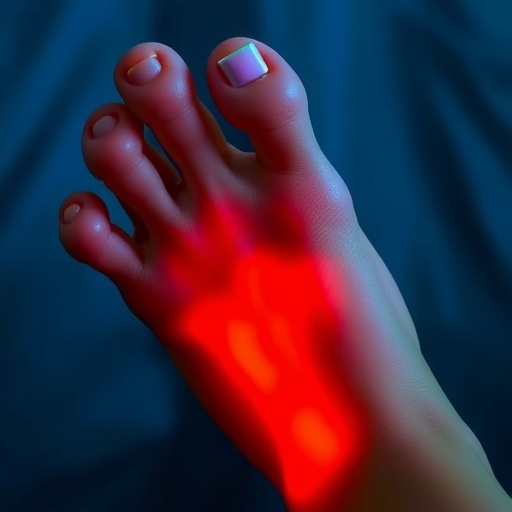Recent research has illuminated the potential of topical melatonin as a promising adjunct in the management of diabetic foot ulcers. This study, conducted by a team of investigators lead by Ahmadvash and colleagues, presents compelling evidence from a double-blind, randomized clinical trial that addresses the difficulties in healing diabetic ulcers, which affect millions of individuals globally. The integration of melatonin, a hormone known for its antioxidant properties, into the treatment regimen for such ulcers could signal a paradigm shift in how we approach wound care for diabetic patients.
Diabetic foot ulcers are chronic wounds that arise as a complication of diabetes, stemming primarily from neuropathy and peripheral vascular disease. The challenge in treating these ulcers lies in their tendency to become infected and the slow rate at which they heal, often leading to severe complications, including the need for amputations. Traditional treatments focus on improving blood flow and controlling infection; however, they have limitations that necessitate the exploration of novel therapies. This study evaluates the effectiveness of melatonin delivered topically, seeking to find an effective solution that can accelerate healing processes.
The trial’s meticulous design ensured robust findings. Researchers enrolled a significant cohort of diabetic patients suffering from foot ulcers and randomly assigned them to receive either topical melatonin or a placebo. Furthermore, the double-blind nature of the trial guarantees that neither the participants nor the researchers knew who received the active treatment or placebo, thus minimizing bias. The primary outcome measured was the percentage reduction in ulcer area over a defined treatment period, along with secondary outcomes including adverse events and patient-reported outcomes regarding pain and overall comfort.
The results revealed that patients receiving the topical melatonin reported greater reductions in ulcer size compared to those in the control group. After the specified treatment duration, the healing rates were markedly higher among those treated with melatonin, and the product was well-tolerated with limited adverse effects reported. These findings align with existing literature suggesting the beneficial effects of melatonin beyond its hormonal functions, particularly its role in modulating inflammatory responses—a significant factor in wound healing.
Melatonin’s mechanisms of action are multifaceted. As an antioxidant, it may reduce oxidative stress in fibroblasts, which are crucial for tissue repair. Furthermore, melatonin has been proposed to enhance antioxidant enzyme activity, promote hydration of the wound bed, and modulate the immune response to prevent infection. Collectively, these properties position melatonin as not just a supplemental treatment, but potentially a key player in the complex biological dance of wound healing, particularly in the context of diabetes.
In an era where the medical community is constantly seeking integrative and holistic approaches to treatment, the introduction of topical melatonin could revolutionize diabetic foot ulcer management. By combining traditional methods, such as wound debridement and infection control, with innovative solutions like melatonin therapy, healthcare providers can offer a more comprehensive strategy that addresses not only the symptoms but the underlying complications of diabetic ulcers.
Moreover, patient quality of life must not be overlooked. Ulcers can cause significant physical pain and emotional distress, impacting daily activities and overall well-being. Improved healing rates translate into enhanced comfort and faster return to normal daily functions for patients. The implications of this study extend beyond mere clinical metrics; they touch on the lived experiences of those affected by diabetes and their journey toward healing.
Despite the positive outcomes detailed in the trial, it is essential to acknowledge the limitations of the study. The sample size, while significant, may still be insufficient to generalize to the broader diabetic population. As with any clinical research, further studies—including larger, multicentric trials—are needed to verify these promising results and to fully understand the optimal dosing regimens and long-term effects of melatonin in this population.
As the medical community digests the findings of this trial, one must consider the accessibility and cost-effectiveness of implementing melatonin therapy in various healthcare settings. Consideration of these factors will be crucial in determining how widely this treatment can be integrated into standard care practices for diabetic foot ulcers across different regions, particularly in lower-resource settings where diabetes care may be less robust.
In conclusion, the double-blind, randomized clinical trial spearheaded by Ahmadvash et al. provides an exciting glimpse into the future of diabetic foot ulcer management with the introduction of topical melatonin. As researchers and clinicians continue to explore this avenue, the hope is that a scalable and effective treatment option may soon be available to improve the lives of many suffering from this debilitating complication of diabetes, driving progress towards improved healthcare solutions.
Combining detailed research findings with patient-centric perspectives, this study not only offers hope for innovations in wound care but also exemplifies the ongoing efforts in the field of endocrinology and diabetes management to utilize synthetic and natural substances in therapeutic avenues.
Subject of Research: The safety and efficacy of topical melatonin in healing diabetic foot ulcers.
Article Title: Safety and efficacy of topical melatonin add-on in healing of diabetic foot ulcer: a double blind, randomized clinical trial.
Article References:
Ahmadvash, F., Gharabagh, L.H., Emami, S. et al. Safety and efficacy of topical melatonin add-on in healing of diabetic foot ulcer: a double blind, randomized clinical trial.
BMC Endocr Disord 25, 254 (2025). https://doi.org/10.1186/s12902-025-02057-1
Image Credits: AI Generated
DOI: https://doi.org/10.1186/s12902-025-02057-1
Keywords: melatonin, diabetic foot ulcer, healing, clinical trial, antioxidants, treatment.




